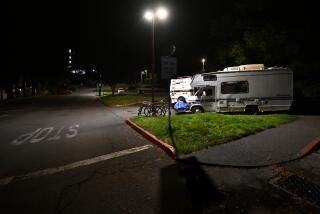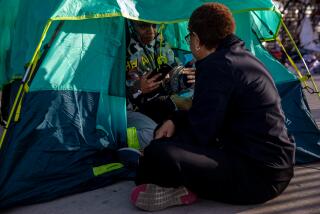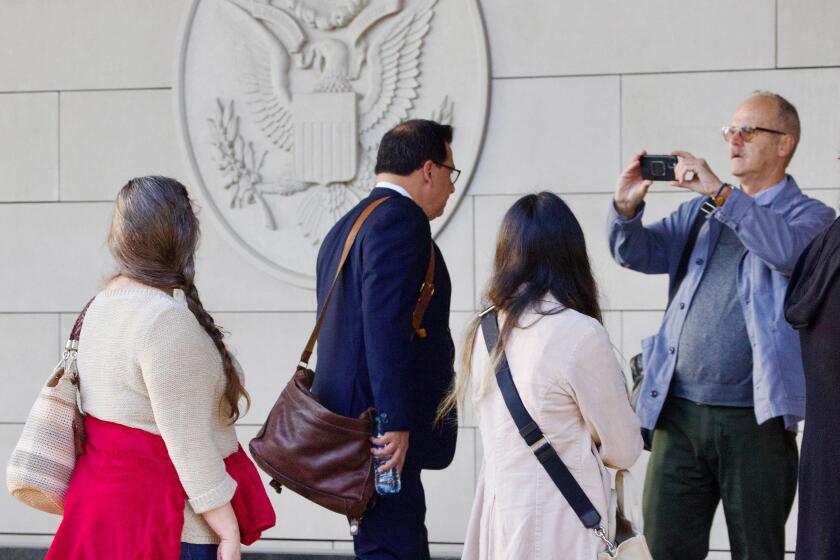Column: Last year, she was sleeping in her car. Today she’s proof homeless stories can have happy endings
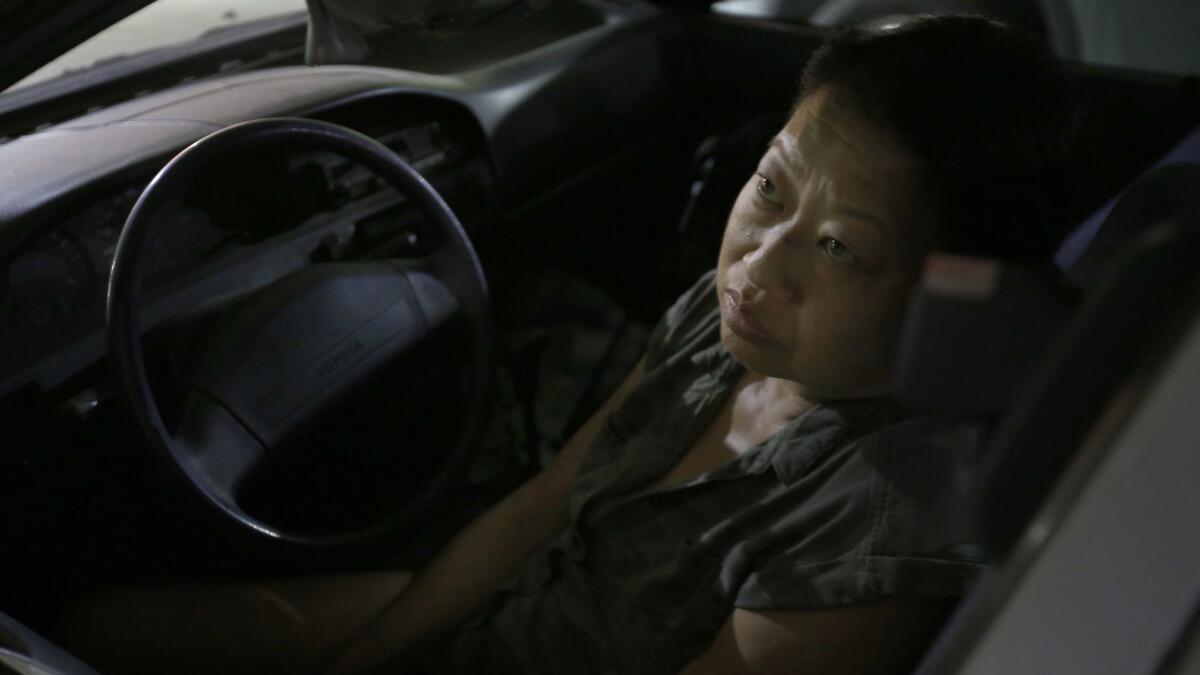
One thing I never understood about Meg Shimatsu was how she kept her spirits up, given her health problems and her circumstances.
When I wrote about the former legal secretary a little over a year ago, she was living in a 1990 Toyota Corolla but figured things could be worse, given how many people she saw in tents.
“I consider myself luckier than most homeless people,” she told me at the time.
Shimatsu has spent years on a waiting list for a kidney transplant, and for more than a year, she parked the Toyota in the lot of the Glendale hospital where she gets dialysis treatment. At night, unable to afford a home on her disability check, she curled up in the back seat of the Corolla, closed her eyes and went to sleep.
We’ve stayed in touch since then. Shimatsu reads the paper and sends me her thoughts on current events. But 10 days ago she had another reason to check in.
“Hey Steve,” she wrote, “just wanted to let you know that I’m no longer homeless.”
So that’s one down, more than 50,000 to go here in the homeless capital of the United States. If you look at it that way, you can easily get discouraged about the monumental human catastrophe and the sprawl of tent cities. But rather than dwell on that now, I decided to take a look at how Shimatsu made it home, and to see if there’s something we can learn from her experience.
More than a year ago, a friend told Shimatsu she should check out the Women’s Room at Friends in Deed, a Pasadena nonprofit whose motto is “Doing together what we cannot do alone.” The interfaith organization reaches out to people living on the edge and tries to help them transform their lives. The Women’s Room is a drop-in program for women who are homeless or close to it — a place to rest safely, do laundry, get a healthy meal, and get hooked up with housing services and other support.
Marlene Martinez, the program director, works in conjunction with another Pasadena nonprofit, Affordable Housing Services, that was looking for women interested in sharing a five-bedroom town home in northwest Pasadena. Martinez knew that Shimatsu was one of several Women’s Room clients who might be an ideal tenant, based partly on her ability to devote roughly one-third of her disability income to pay the subsidized rent.
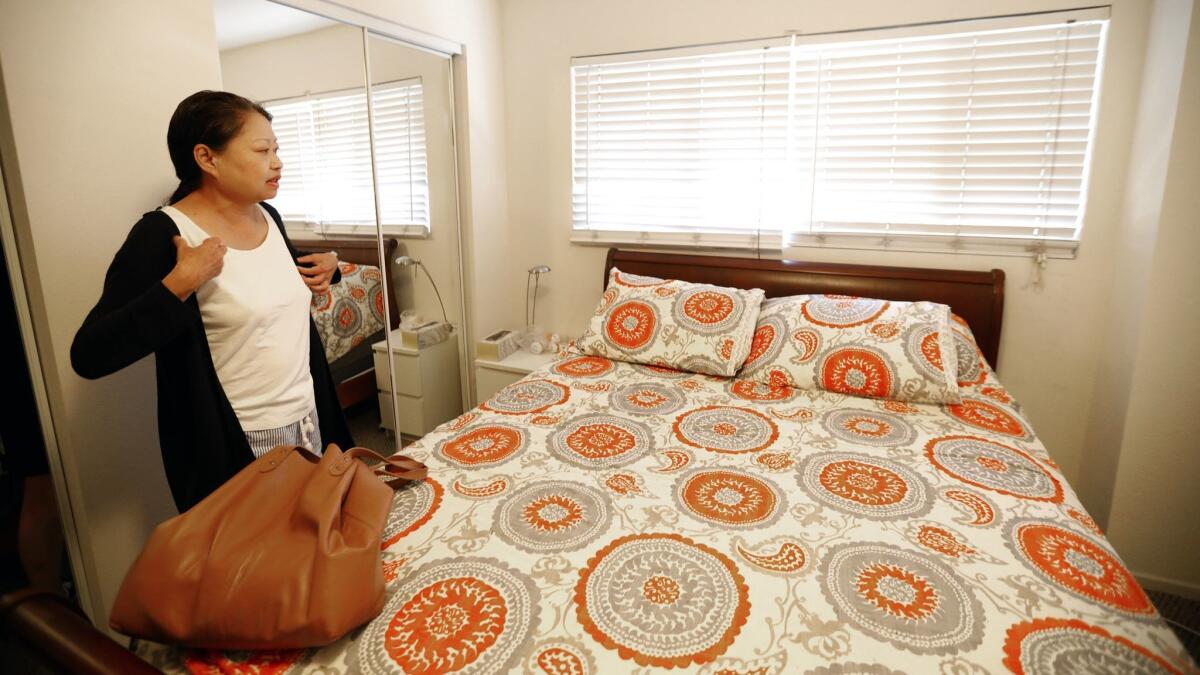
“We’re a small nonprofit housing provider,” said Michelle White, executive director of Affordable Housing. In the 1990s, White’s agency bought eight single-family town homes that were in foreclosure. In recent years, when two of the families moved out, the agency decided to address the growing need for housing among older homeless women by converting two of the units into shared homes. So five women each get their own bedroom, and the kitchen, living room and bathrooms are shared spaces.
How does a small nonprofit like Affordable Housing Services buy real estate in an expensive market?
White said her agency initially bought the town homes from Fannie Mae, the Federal National Mortgage Assn., with assistance from parishioners of Pasadena’s All Saints Church. That seed money was supplemented by Pasadena city grants and loans and conventional private market financing.
“That’s a typical way nonprofits buy housing,” said White, who explained the process of cobbling together money from multiple sources.
Not everyone wants to share space in a home, said Rabbi Joshua Levine Grater, Friends in Deed’s executive director.
“Some people feel like they may have only one shot at housing, and they hold out for their own unit,” Grater said.
They may have a pet they’re unwilling to part with, he said, or they worry that they won’t mesh with other tenants, or they don’t have a stable enough income to feel comfortable about signing a one-year lease.
In my experience, some people who have nothing eventually come to terms with the idea that at least they have nothing left to lose. And they fear not being able to handle the pressure of suddenly having something they might not be able to hold on to.
But one Women’s Room client jumped at the opportunity and moved in right away. Shimatsu had some trepidation at first and wanted to check out the living arrangements before committing. But she liked what she saw.
“It looked like everything was modern and up to date. There were ceiling fans, tiles, wood floors. It was very nice,” said Shimatsu, who also liked the tree-shaded patio and the serenity of a unit set back from the street.
Two weeks ago, she moved in.
“The first night was a little hard. In an unfamiliar place, sleeping can be difficult. But it’s better now,” Shimatsu said.
“Sleeping in a car is bad for your back, but believe it or not, I got used to it,” she added. Shimatsu had upgraded to a more comfortable 2002 Camry after I wrote about her. But now, sleeping in a bed, her back feels better.
“It’s very comforting to know you can shut the door and you can pretty much do what you want in the comfort of your own home,” Shimatsu said. “Solitude is very nice.”
Pasadena housing director Bill Huang said he thinks that in a region with tens of thousands of homeless people, there’s great potential in shared housing arrangements like this. He cited one example in which three men are sharing a three-bedroom, two-bath house.
“It’s cheaper and faster to acquire 10 three-bedroom homes that can house 30 people than to build a new 30-unit apartment building,” said Huang, “and there’s less neighborhood impact.”
When Shimatsu moved in, the Women’s Room, with the aid of its many devoted volunteers, helped gather donations of bedding, linens, cookware and toiletries. That spirit of generosity, along with the original help from All Saints parishioners, and donations from Times readers who saw Shimatsu’s story last year, had Rabbi Grater thinking about the prayers and sermons he delivered at synagogues when celebrating Rosh Hashana.
“Who by hunger and who by thirst,” he said. “Who shall live and who shall die.”
This is a time of year, Rabbi Grater said, to honor the idea that “good deeds, repentance and prayer make the pain more bearable.”
I took Shimatsu to lunch Tuesday with Times photographer Francine Orr, who documented Shimatsu’s nightly ordeal in the Toyota Corolla. Shimatsu expressed her gratitude for the staff and volunteers at the Women’s Room, and for the generosity and dedication of the folks at Affordable Housing Services.
After lunch, we went to check out her new home.
Shimatsu turned the key and took us into the living room and kitchen, then led us upstairs to show us her bright, lovely new bedroom. Outside, in the garden, she wanted us to see the pomegranate tree, which was full of fresh fruit, and a nearby lemon tree promised a robust harvest.
“Sometimes,” Shimatsu had said in her text to me, “there is a happy ending.”
Get more of Steve Lopez’s work and follow him on Twitter @LATstevelopez
More to Read
Start your day right
Sign up for Essential California for news, features and recommendations from the L.A. Times and beyond in your inbox six days a week.
You may occasionally receive promotional content from the Los Angeles Times.

